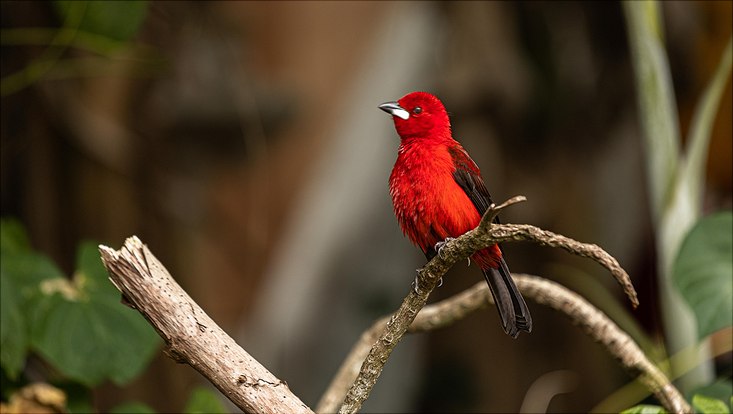and Society (CLICCS)
Protected AreasUsing strategy to preserve biodiversity while saving space
16 December 2021, by Stephanie Janssen

Photo: D Alvesd-unsplash
The breathtaking variety of life on Earth is in danger; biodiversity is declining rapidly. As many as one million species are at risk; many could become extinct in the next few decades. Accordingly, protected areas are urgently needed, but are often poorly chosen from a strategic perspective. But how can the biological diversity of a given region best be measured? With the aid of an innovative new approach, a team of researchers from Bogotá, together with Dr. Kerstin Jantke from Universität Hamburg, have now identified the most valuable areas in Latin America.
In South and Central America, an especially high number of biodiverse areas are in jeopardy. Tropical rainforests are being cleared so that the land can be used for livestock grazing and planting soybeans. To compensate for these losses, other areas need to be placed under protection. The United Nations plans to protect 30 percent of global landmass by 2030; currently, the 17-percent benchmark still applies.
At Universität Hamburg’s Cluster of Excellence for climate research CLICCS, environmental expert Kerstin Jantke is working to select protected areas in such a way as to preserve as many species and ecosystems as possible – while simultaneously having to compete with agricultural areas as little as possible. This aspect is not only essential for biodiversity; it also boosts the acceptance of preservation measures. Moreover, suitable protected areas can enhance ecosystems’ ability to adapt to climate change.

Together with Jantke, a team from Pontifical Javeriana University and the Alexander von Humboldt Biological Resources Research Institute in Bogotá, Colombia, led by Dr. Jaime Burbano-Girón, have now redefined the indicators for biological diversity and published their findings in the journal Biological Conservation. Distribution maps of the target area were already available for threatened amphibians, birds, mammals and reptiles, a total of 8,563 species. To date, the species’ geographic distribution has frequently been used as a parameter: wherever there are many species, the biological diversity is qualitatively high. Yet the number of species alone doesn’t determine a given region’s biological importance.
“Biodiversity is highly complex. If I only look at the species, I can’t see their functions within the ecosystem. Are they predators or prey? What do they eat, where do they live, and how large is their biomass?” Jantke explains. Consequently, for the first time the team also analyzed the geographic locations of the 633 ecosystems and 5,382 ecological groups in the Tropics of Latin America using a computer model, and compared this aspect with the species distribution.
Their efforts have yielded three geographic maps that show which areas are optimally suited for protecting 17 percent of every species, 17 percent of every ecosystem, and 17 percent of every functional group, respectively. In a nutshell: the areas don’t match, which tells us that species distribution alone isn’t a sufficient indicator of biodiversity. According to the study, it only reflects 50 to 62 percent of the three aspects of biodiversity examined.
To make matters worse, in many cases, nature conservation areas aren’t systematically selected, which means the wrong areas are placed under protection. In Brazil, for example, 30 percent of the land area is already officially protected, yet less than 17 percent of every species, ecosystem and ecological group is protected. “It’s time to start selecting protected areas strategically and sustainably,” says Burbano-Girón. “Otherwise, more time, land and money will be wasted.”
In addition, the team identified a number of biodiversity “hotspots,” each of which is home to a broad range of species, ecosystems and functional groups alike – but none of which are currently sufficiently protected. “Critical areas can be found in Gran Chaco, the Atlantic Forest, Pantanal, Cerrado, the Caatinga regions, and in the moist and dry forests of the Northern Andes and Middle America,” says Burbano-Girón. “They are all valuable areas for diversity and in urgent need of protection.”
Further Information
Publication:
Burbano-Girón J, Jantke K, Molina-Berbeo MA, Buriticá-Mejía N, Urbina-Cardona JN, Sánchez-Clavijo LM, Etter A (2022): An assessment of spatial conservation priorities for biodiversity attributes: Composition, structure, and function of Neotropical biodiversity; Biological Conservation, Vol. 265
Pictures for download:
Maps: The maps show the spatial distribution of sites if a protected area was selected according to the distribution of (A) species, (B) ecosystems or (C) functional ecological groups. Map F shows how differently the protected areas would be located if they were selected according to only one biodiversity characteristic. Credit: Jaime Burbano-Girón et al. Download here (jpg).
Bird Picture: Credit: Danilo Alvesd/unsplash. Download here (jpg)
Contact:
Dr. Kerstin Jantke
Universität Hamburg
Centrum für Erdsystemforschung und Nachhaltigkeit (CEN)
Exzellenzcluster Climate, Climatic Change, and Society (CLICCS)
E-Mail: kerstin.jantke@uni-hamburg.de
Tel: +49 (0) 40 42838 5744
Stephanie Janssen
Öffentlichkeitsarbeit/Outreach
Universität Hamburg
Centrum für Erdsystemforschung und Nachhaltigkeit (CEN)
Exzellenzcluster Climate, Climatic Change, and Society (CLICCS)
Email: stephanie.janssen@uni-hamburg.de
Tel: +49 (0) 40 42838 7596


